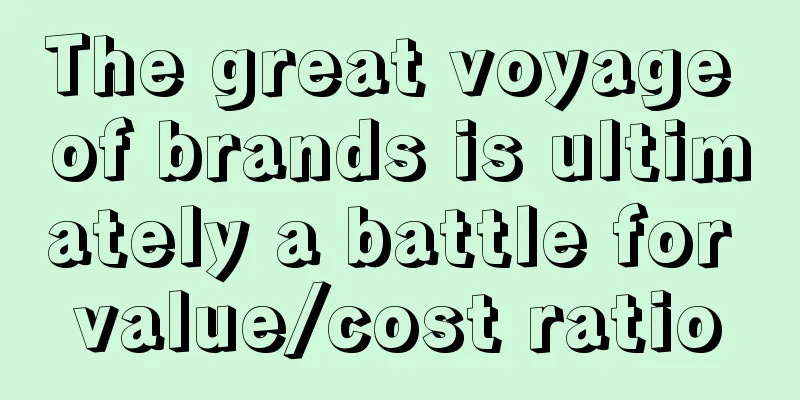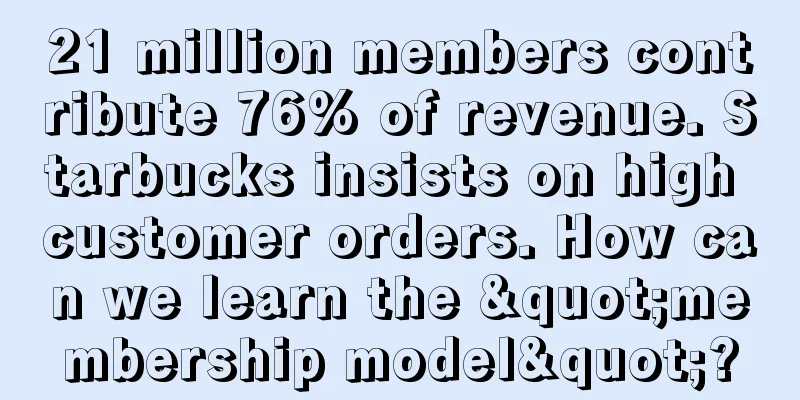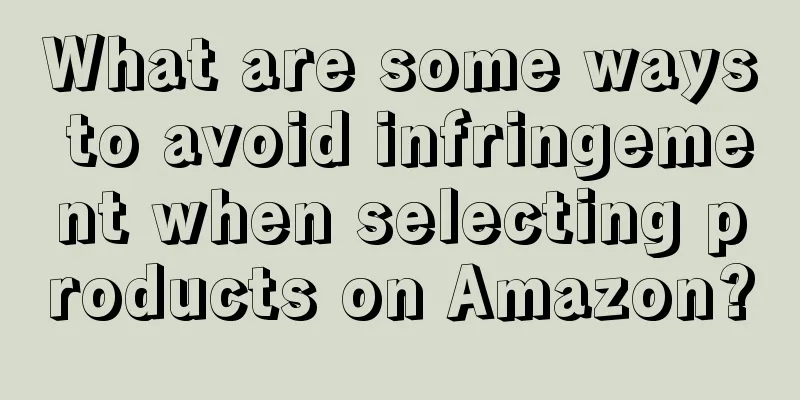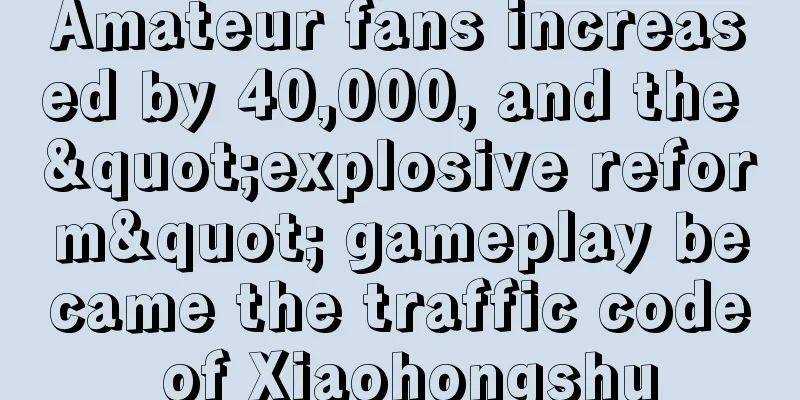The great voyage of brands is ultimately a battle for value/cost ratio

There are two types of markets: competitive market and monopoly market. A competitive market means that there is competition between companies. Users can filter by themselves to see who provides more value that is worth paying for. Everyone will do some calculations in their mind to measure the value and cost to see if it is worthwhile. The greater the difference between value and cost, the more attractive it is. Monopolizing the market is a different matter. There is no such thing as worth it or not because you have no choice. There are two main ways to look at a monopoly market: long-term and short-term. For the long-term, you can tell by looking at which company or companies dominate the industry. You can also get a rough idea by looking at the top companies in these industries being fined under the Anti-Monopoly Law. In the short term, it can be basically understood as doing one-time business, or doing business with extremely low frequency, such as many merchants in airports and high-speed rail stations. They are not doing repurchase rate, but based on the big pain points and small choices (or even no choice) of huge passenger flow. Of course, there is another situation, which is impulse buying. At a certain moment, emotion overwhelms reason, and after buying, you still feel that you are "impulsive". From the perspective of the long-term business, this is a low-probability event, or an unsustainable event (for most industries). First, the overall proportion of business contribution is small, and second, it will lead to an extremely high return rate (for most products), which will eventually backfire. Products solve the problem of cost-effectiveness, and the brand as a whole solves the logic of [value/cost ratio]. 1. Cost-effectiveness is a comparative advantageCost-effectiveness is the root of product strategy thinking and the source of brand strategy. If cost performance is based on product performance, then value-to-cost ratio is the dimension of overall value. If investment is value investment, then consumption will also be value consumption. First of all, let’s talk about cost-effectiveness. It is not simply a low price, nor is it an excuse for insufficient performance (although many companies take this approach). It is a set of parameters, a ratio, which is the ratio of performance to price, or it can be understood as the difference between performance and price. The larger the value, the stronger the attractiveness. As Lei Jun said, cost performance is not about absolute price, let alone low price. Cost performance is about comparative advantage, that is, the best performance at the same price, and the lowest price at the same performance. Xiaomi's logic for hot products is to use this cost-effective thinking to re-invent the traditional industry. A classic example is Xiaomi TV. In 2022, against the backdrop of a 5.6% decline in global smart TV shipments, Xiaomi TV shipments reached 12.4 million units, a year-on-year increase of 0.6%, and shipments remained in the top five in the world. Even in the socket industry, the redesign has affected the product strategy of socket giant Bull, and Xiaomi's pricing is also set in the mid-to-high-end. Just as Duan Yongping said: I agree that Apple products are cost-effective. Cost-effective things are not necessarily cheap. People who should know will eventually know (2014-08-28). Everyone will look at cost-effectiveness, but everyone has different sensitivity to price. Also, everyone has different views on money. (2013-02-27). Users will not buy just because you offer a low price. People will not buy a bunch of useless things at a low price. The core essence of business is based on the exchange of value. What users want is value, and then they need to measure it with price. 2. Value-to-cost ratio is a long-term advantageThe reason for raising the concept of value-cost ratio is mainly to find out the driving force behind users’ purchase of products, and on this basis, to find the points that really impress them. The value here is a more systematic concept, which is mainly divided into product functional value and brand emotional value. The emotional value here includes the attractiveness of the design, internal psychological satisfaction, external social currency, and even the value of the currency in circulation (for example, Moutai is a hard currency with its own financial attributes). The cost here is more comprehensive. On the basis of monetary cost, time and energy costs are added. The essence of business is based on efficiency, and the current consumer culture is also affected by efficiency. When we look at it from this perspective, we will understand that Luckin's 9.9 yuan is not only a matter of money, but also a matter of time (short waiting time and short walking distance) and energy (the store coverage density is large, and it does not take much energy to walk). Why do people usually pick up Luckin Coffee at the store? Because takeout is more expensive, and there is a 6 yuan delivery fee. From the way of thinking that you get what you pay for, to the logic of thinking that you get half a cent for what you pay for. In fact, what we are talking about is not a tongue twister, but we want to say that the subtle differences in thinking logic will affect our specific direction and behavioral actions. You get what you pay for is a term that starts from the perspective of price, and basically leads to two conclusions: cheap products are not good, and expensive products have their reasons. The "one cent for one product" approach focuses on the product, finding the core value of the product at the enterprise level, and then giving users an exciting price. You get what you pay for is just a descriptive concept and does not refer to specific numbers. The key is to find the difference, and this difference is the potential difference between you and your competitors. Users may not necessarily pay for good services, but they are very likely to refuse to pay for bad services. Service is also a kind of value, representing the meaning behind it, whether it is an unexpected surprise or a jaw-dropping shock. The former is caring, and the latter is an offense. Faced with offense and optional context, users will vote with their feet without hesitation. Talking about value without considering demand is just hooliganism. Value has boundaries, because each group has a different understanding of value. Differences in economic strength and views on money between different groups will affect their judgments. Talking about toxicity without considering dosage, and talking about value without considering demand, are both rogue behaviors. ConclusionConcepts are a means to help us understand and summarize, but they are not the ultimate goal. In the long run, the business world always follows this rule: value determines price, and prices fluctuate around value. Author: Zang Feng; WeChat public account: Strategist Zang Feng |
<<: Live streaming saves itself, Tianya is unlikely to become the next Dongfangzhenxuan
>>: Top 10 Marketing Keywords in 2023
Recommend
Internet giants are starting to grab new turf
During the Spring Festival holiday, the short play...
As the Games get underway, brands are also competing in Olympic advertising
The Olympics is not only a feast of sports competi...
A marketing strategy for May, please check it out
There are many festivals in May that can be used f...
How to open a store on Shopee without a source of goods? What is the entry process?
Now many friends are engaged in cross-border e-com...
6 types of people who can definitely make money on TikTok!
Uncover the six types of people who make money on ...
The "huge wealth" of bees and flowers cannot be achieved by relying solely on free traffic
As the Li Jiaqi incident continued to ferment, tra...
AI whistleblower banned from the entire Internet! OpenAI and 25 other organizations use a trick to identify AI robots at a glance
AI agents are all over the network. How can we pre...
Must learn! Xiaohongshu released [Store Broadcast 3+3 Management Method]!
Xiaohongshu has just released the "Simple Liv...
Will Tik Tok “take over” from Weibo?
Although Douyin and Weibo belong to different fiel...
Who is copying Zhang Xuefeng?
Recently, topics related to the college entrance e...
What personality types are suitable for being a data analyst?
This is a series of data analysis job interviews. ...
DeepSeek per person, from top to bottom
From lawyers, journalists to real estate agents, a...
Moutai, which has been played as "cooking wine", has stopped co-branding. What lessons can this bring to the brand?
From Moutai's joint venture carnival to the su...
How is the profit of temu platform? How to settle accounts on temu platform?
There are thousands of high-quality domestic and f...
Shopee's Compliance Tips on New Export Control Regulations on Drones and Drone-Related Items
Shopee platform issued a compliance reminder on th...









